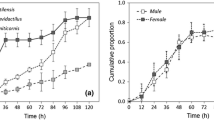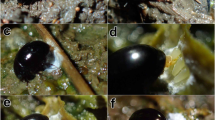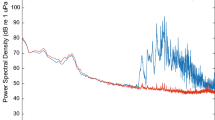Abstract
Mud snails (Ilyanassa obsoleta = Nassarius obsoletus = Nassa obsoleta) deposit eggs in protective capsules on hard substrata in soft bottom environments. We studied sites of egg capsule deposition and snail movement responses to odors to determine if chemoreception plays a role in deposition site selection. From results of field surveys, laboratory experiments, and field experiments, we conclude that mud snails use chemoreception for capsule deposition. Attractive odors originate from mud snail and whelk egg capsules and from living bivalves. Evidence for attractive odors from conspecifics is equivocal. Capsules are deposited on living odor sources and nearby hard substrates. We hypothesize that deposition of capsules on living substrates increases the likelihood that embryos will survive by decreasing the chance of smothering of embryos by sediments.
Similar content being viewed by others
REFERENCES
Achituv, Y. and Susswein, A. 1985. Habitat selection by two Mediterranean species of Aplysia: A. fasciata Poiret and A. depilans Gmelin (Mollusca: Opisthobranchia). J. Exp. Mar. Biol. Ecol. 85: 113–122.
Atema, J. and Burd, G. D. 1975. A field study of chemotactic responses of the marine mud snail, Nassarius obsoletus. J. Chem. Ecol. 1:243–251.
Atema, J. and Stenzler, D. 1977. Alarm substance of the marine mud snail Nassarius obsoletus: biological characterization and possible evolution. J. Chem. Ecol. 3:173–187.
Audesirk, T.E. 1977. Chemoreception in Aplysia californica. III. Evidence for pheromones influencing reproductive behavior. Behav. Biol. 20:235–243.
Audesirk, T. E. 1979. A field study of growth and reproduction in Aplysia californica. Biol. Bull. 157:407–421. 2268 RITTSCHOF, SAWARDECKER, AND PETRY
Blankenship, J. E., Rock, M. K., Robbins, L. C., Livingston, C. A., and Lehman, H. K. 1983. Aspects of copulatory behavior and peptide control of egg laying in Aplysia. Fed. Proc. 42:96–100.
Bretz, D. D. and Dimock, R. V. 1983. Behaviorally important characteristics of the mucous trail of the marine gastropod Ilyanassa obsoleta (Say). J. Exp. Mar. Biol. Ecol. 71:181–191.
Carr, W.E. S. 1967a. Chemoreception in themudsnail Nassarius obsoletus. I. Properties of stimulatory substances extracted from shrimp. Biol. Bull. 133:90–105.
Carr, W. E. S. 1967b. Chemoreception of the mud snail, Nassarius obsoletus. II. Identification of stimulatory substances. Biol. Bull. 133:106–127.
Carriker, M. R. 1955. Critical Reviews of Biology and Control of Oyster Drills Urosalpinx and Eupleura. Special Scientific Report: Fisheries No. 148. US Fish andWildlife Service Washington, DC.
Crisp, M. 1969. Studies on the behavior of Nassarius obsoletus (Say) (Mollusca Gastropoda). Biol. Bull. 136:335–373.
Curtis, L. A. 1985. The influence of sex and trematode parasites on carrion response of the estuarine snail Ilyanassa obsoleta. Biol. Bull. 169:377–390.
Curtis, L. A. 1987. Vertical distribution of an estuarine snail altered by a parasite. Science 235:1509–1511.
Dimon, A. C. 1905. The Mud Snail: Nassa obsoleta. Cold Spring Harbor Monograph, 47 pp.
Dix, T. L. and Hamilton, P. V. 1993. Chemically mediated escape behavior in the marsh periwinkle Littoraria irrorata Say. J. Exp. Mar. Biol. Ecol. 166:135–149.
Duval, M. A., Calzetta, A. M., and Rittschof, D. 1994. Behavioral responses of Littoraria irrorata (Say) to water-borne odors. J. Chem. Ecol. 20:3321–3334.
Gore, R. H. 1966. Observations on the escape response in Nassarius vibex (Say), (Mollusca, Gastropoda). Bull. Mar. Sci. 16:423–434.
Hadfield, M. G. and Pennington, J. T. 1990. Nature of the metamorphic signal and its internal transduction in larvae of the nudibranch Phestilla sibogae. Bull. Mar. Sci. 46:455–464.
Jahan-Parwar, B. 1976. Aggregation pheromone from the egg-mass of Aplysia. The Physiologist 19:240.
Jenner, C. E. 1957. Schooling Behavior in mud snails in Barnstable Harbor leading to the formation of massive aggregations at the completion of seasonal reproduction. Biol. Bull. 113:328.
Kupfermann, I. and Carew, T. 1974. Behavior patterns of Aplysia californica in its natural environment. Behav. Biol. 12:317–337.
Oberdoerster, E., Rittschof, D., and McClellan-Green, P. 1998. Testosterone metabolism in imposex and normal I. obsoleta: studies with field collected and TBT C1-induced imposex snails. Mar. Pollut. Bull. 36:144–151.
Painter, S. D. 1992. Coordination of reproductive activity in Aplysia: Peptide neurohormones, neurotransmitters, and pheromones encoded by the egg-laying hormone family of genes. Biol Bull. 183:165–172.
Painter, S. D., Chong, M. G., Wong, M. A., Gray, A., Cormier, J., and Nagle, G. T. 1991. Relative contributions of the egg layer and egg cordon to pheromonal attraction and the induction of mating and egg-laying activity in Aplysia. Biol Bull. 181: 81–94.
Painter, S. D., Clough, B., Garden, R.W., Sweedler, J.V., and Nagle, G.T. 1998. Characterization of Aplysia attraction, the firstwater-borne peptide pheromone in invertebrates. Biol. Bull. 194:120–131.
Painter, S. D., Clough, B., Akalal, D. B. G., and Nagle, G. T. 1999. Attractin, a water-borne peptide pheromone in Aplysia. Invert. Reprod. Dev. 36: 191–194.
Rahman, Y. J., Forward, R. B., JR., and Rittschof, D. 2000. Responses of snails and periwinkles to environmental odors and disaccharide mimics of fish odor. J. Chem. Ecol. 26:679–696.
Rittschof, D. 1993. Body odors and neutral-basic peptide mimics: a review of responses by marine organisms. Am. Zool. 33:487–493. MUD SNAIL SPAWNING 2269
Rittschof, D. and Gruber, G. 1988. Response to prey odors by oyster drills, Urosalpinx cinerea cinerea, Urosalpinx cinerea follyensis and Eupleura caudata etterae. Mar. Behav. Physiol. 13:185–199.
Rittschof, D., Williams, L. G., Brown, B, and Carriker, M. R. 1983. Chemical attraction of newly hatched oyster drills. Biol. Bull. 164:493–505.
Rittschof, D., Shepherd, R., and Williams, L. G.. 1984. Concentration and preliminary characterization of a chemical attractant of the oyster drill Urosalpinx cinerea. J. Chem. Ecol. 10:63–79.
Sastry, A. A. 1971. Effect of temperature on egg capsule deposition of the mud snails, Nassarius obsoletus(Say). Veliger 13:339–341.
Scheltema, R. S. 1967. The relationship of temperature to the larval developmetn of Nassarius obsoletus (Gastropoda). Biol. Bull. 132:253–265.
Smith, B. S. 1971. Sexuality in the American mud snail Nassarius obsoletus (Say). Proc. Malacol. Soc. London 39:377–378.
Smith, B. S. 1980. The estuarine mud snail, Nassarius obsoletus: abnormalities in the reproductive system. J. Mollusc. Stud. 46:247–256.
Smith S. T. and Carefoot, T. H. 1967. Induced maturation of gonads in Aplesia punctata Curvier. Nature 215: 652–653.
Snyder, N. F. R. 1967. An alarm reaction of aquatic gastropods to intraspecific extract. Cornell University Agriculture Experiment Station Memoir 403.
Stenzler, D. and Atema, J. 1977. Alarm response of the marine mud snail, Nassarius obsoletus: specificity and behavioral priority. J. Chem. Ecol. 3:159–171.
Susswein, A. J., Gev, S., Feldman, E., and Markovitch, S. 1983. Activity patterns and time budgeting of Aplysia fasciata under field and laboratory conditions. Behav. Neural Biol. 39:203–220.
Susswein, A. J., Gev, S., Achituv, Y., and Markovitch, S. 1984. Behavioral patterns of Aplysia fasciata along the Mediterranean coast of Israel. Behav. Neural Biol. 41:7–22.
Trott, T. J. and Dimock, R. V., JR. 1978. Intraspecific trail following by the mud snail Ilyanassa obsoleta. Mar. Behav. Physiol. 5:91–101.
Thompson, T. E. and Bebbington, A. 1969. Structure and function of the reproductive organs of three speices of Aplesia (Gastropoda: Opistobranchia) Malocolgica. 7:347–380.
Walpole, R. E. 1974. Introduction to Statistics. Macmillan, New York 340 pp.
Author information
Authors and Affiliations
Corresponding author
Rights and permissions
About this article
Cite this article
Rittschof, D., Sawardecker, P. & Petry, C. Chemical Mediation of Egg Capsule Deposition by Mud Snails. J Chem Ecol 28, 2257–2269 (2002). https://doi.org/10.1023/A:1021001416480
Issue Date:
DOI: https://doi.org/10.1023/A:1021001416480




